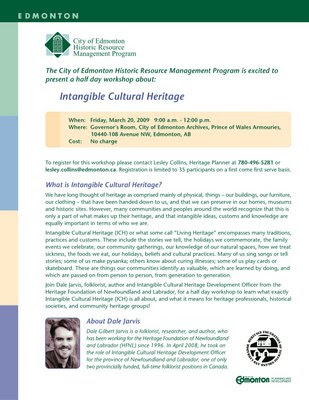The City of Edmonton Planning and Development Department, in cooperation with the Heritage Foundation of Newfoundland and Labrador, is pleased to present a half day workshop on Intangible Cultural Heritage. The workshop will be lead by Dale Jarvis, a well known storyteller, author and folklorist who currently serves as the Intangible Cultural Heritage Officer with the Heritage Foundation of Newfoundland and Labrador. Dale will guide participants through an overview of intangible cultural heritage, help brainstorm some of Edmonton's unique intangible cultural heritage and provide the City with some strategies for protecting and documenting these important connections to our past.
Friday, March 20th, 2009, 9 am to 12 pm
Governor's Room, City of Edmonton Archives, Prince of Wales Armouries
10440 108 Avenue
Edmonton, AB
The event is being organized by Lesley Collins MSc. Pl., Heritage Planner
BRZ & Heritage Conservation Unit, Planning & Policy Services Branch
Planning & Development Department , City of Edmonton
lesley.collins@edmonton.ca

